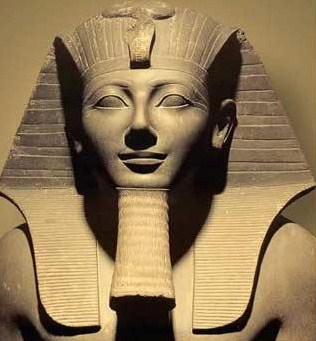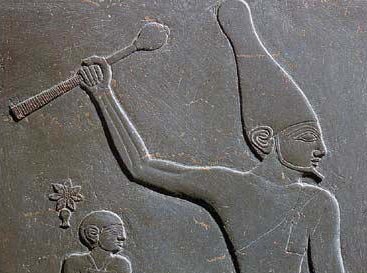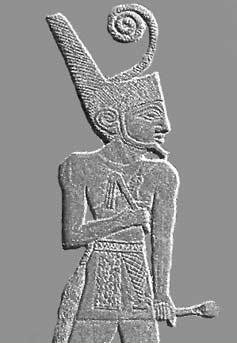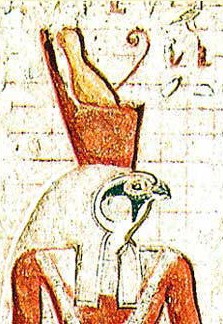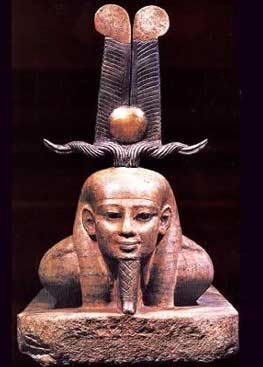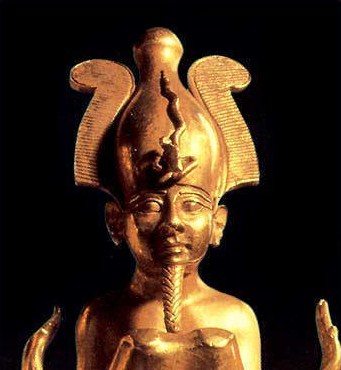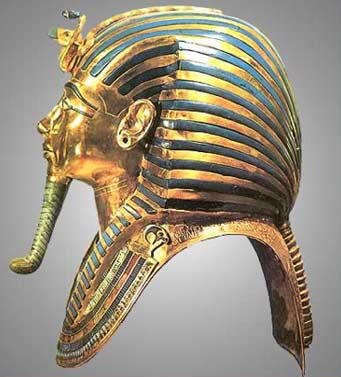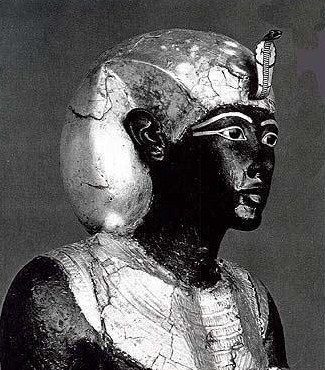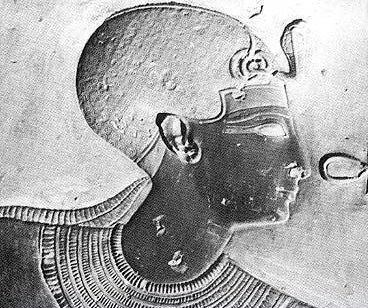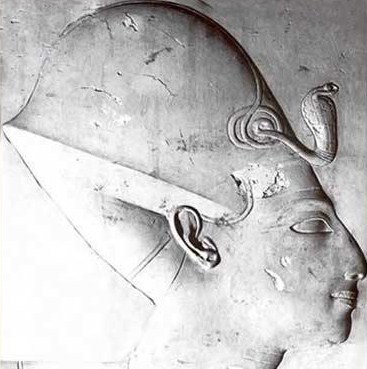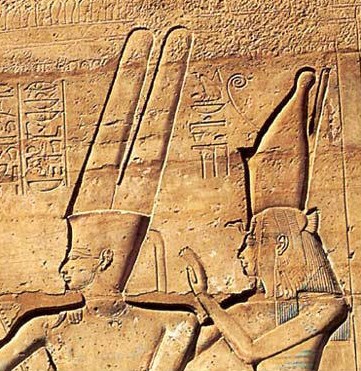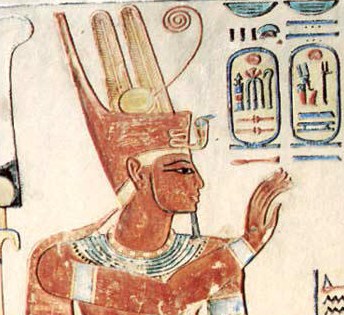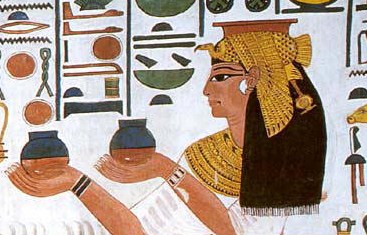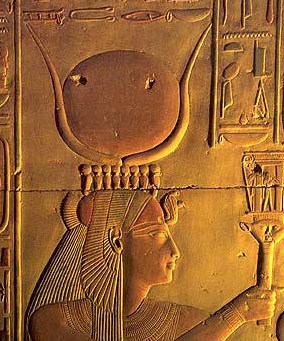 |
 |
 |
Egypt Feature Story The Crowns of Egypt, Part IISpecific Crownsby Jimmy Dunn
There were a variety of crowns in ancient Egypt, which might be categorized as those belonging to kings, those belonging to royal women and those of the gods. Of course, some of the crowns could be shared between these categories, particularly between kings and gods, and one must also remember that a woman who ruled Egypt, such as Hatshepsut, was actually considered a king, and not a queen, and so though a royal woman, she would have worn the crowns of kings. Also, keep in mind that, for symbolic purposes, there is very little difference between the terms, "crown" and "headdress".
There are ten basic types of royal headdresses. The oldest of these, and perhaps the most prominent are the White Crown and the Red Crown, attested from the Predynastic Period onward. They were generally associated with the kingship of the Two Lands, and as such, have been used in debates concerning the earliest kings of the unified Upper and Lower Egypt. We believe that either the kings known as Aha or Narmer could have been one and the same as the legendary founder of Egypt, Menes. Today, a majority of scholars appear to associate Aha with Menes, but on the Narmer Pallet, the king is shown on one side wearing the White Crown and on the other wearing the Red Crown. It should also be noted that there were always a few variations in crowns that are not very well documented.
The While and Red Crowns
The White Crown, most commonly called hdt (The White, or Bright One, or as one of my assistants recently named it, the "bowling pin crown"), adorned the king as ruler of Upper (Southern) Egypt, while the Red Crown, most commonly called dsrt (The Red One) and nt (interpreted from the Middle Kingdom as referring to the goddess Neith), marked him as ruler of Lower Egypt. Though no example of these crowns survive (that we know of), scholars have proposed that they were made of fabric or leather, supplemented in the case of the Red Crown by a "wire" ending in a spiral. Both of these crowns are mentioned in the Pyramid Texts, where their luminous color is associated with the light of celestial bodies.
From the time of Tuthmosis IV, they can be combined with the striped cloth called nemes, and from the 19th Dynasty on they are rarely depicted alone. These two crowns were seen as manifestations of the tutelary goddesses of the Two Lands (Upper and Lower Egypt), Nekhbet and Wadjet, and were glorified in hymns. They were also known as "The Two Great of Magic".
The Double Crown The complementary character of the White and Red Crowns finds expression in their combination as the Double Crown, most commonly called shmty (The Two Powerful Ones). When combined in this manner, the resulting crown symbolized kingship over the entire country. It also is depicted on the heads of gods associated either with kingship, such as Horus or with cosmic rule, like Atum. Worn surmounting the vulture cap, it also forms part of the headdress of the goddess Mut. The Double Crown is attested in representations from the 1st Dynasty onward. It can be found in the Pyramid Texts, and from the Middle Kingdom on, the Double Crown may replace the Red Crown in complementary representations of the Upper and Lower Egyptian crowns.
Interestingly, depictions of the Double Crown seem to be considerably more rare than representations of the White and Red Crowns alone. In two dimensional representations, the double crown is typically depicted in a very stylized manner, with the Red Crown section largely omitted In sculptures depicting the Double Crown, rarely is the curled "wire" present, either because it has been broken off, but more frequently, it would seem to be purposely omitted.
The Two Feathers Crown Another headdress, known as the Double Feathers Crown and principally called swty (The Two Feathers) by the ancient Egyptians, may have a pair of ostrich or falcon feathers. As a royal crown, this type is attested from the reign of Sneferu in the 4th Dynasty onward. The divine (ostrich) Double Feathers, apparently those of the god Anedjti, are first attested in the 6th Dynasty Pyramid Texts. The feathers also adorn gods such as Amun, Min and Montu. Like a number of other crowns, the Double Feathers, usually combined with ram horns, may be adorned with additional uraei and disks from the New Kingdom on.
Some texts suggest that this crown held a special position within the rites surrounding the ruler's accession to the throne, complementing the role of the Double Crown at his coronation. In the religious literature, the swty appears mostly in conjunction with the atef-crown, as an integral part of which the feathers are perceived.
The Atef Crown
The earliest depiction of the Atef Crown dates to the reign of Sahure (5th Dynasty). It consists of a central element, similar in shape to the White Crown, which is woven from plant stems and flanked by two ostrich feathers. Generally worn on top of a wig adorned with the simple circlet and horns, it may, from the New Kingdom onward, also have disks and uraei. The meaning of the word atef, which occurs from the Coffin Texts on, is disputed. It may mean "his might" or "his terror", but scholars are not sure of even this.
The crown is associated particularly with the gods Osiris and Heryshef, the latter embodying the united gods Re and Osiris, the rulers of the sky and netherworld, day and night. According to chapter 175 of the Book of Going Forth by Day (the Book of the Dead), it is bestowed by the sun god. The atef can also be worn by Horus and Re in their various forms. From the time of Tuthmosis III on, the ished-fruit, from the mythic tree that stands on the horizon at sunrise, can replace the solar disk normally surmounting the atef. This symbolism of solar renewal, and related fertility, appears to complement that of the nemes headdress.
The triple atef, Egyptian hmhm (The Roaring One), occurs first under Akhenaten and may have replaced the traditional atef during the Amarna period. Common in representations of the solar child emerging from the lotus flower in the morning, it may identify the king with the sun god at sunrise.
The Nemes
The nemes headdress, attested from the time of Djoser in the early 3rd Dynasty, is worn almost exclusively by the king in representations. Its use on the standards representing the royal ka underlines its significance for kingship. Beginning with the 18th Dynasty, it is depicted mostly in combination with other crowns. It appears to be referred to by the term nws in the Pyramid Texts and is associated with Re-Khepri at sunrise. Another close link is with Horus, who is said in the Coffin Texts to bestow this headdress on his father Osiris in order to bring about the latter's rebirth. The king wears the nemes when represented as a sphinx or falcon. It seems to express the royal "Horus" and "Son of Re" names.
Khat and Afnet Headdresses
Another headdress closely connected with the nemes is the khat or afnet, which it appears to complement. These two kerchiefs generally appear together in the object friezes as well as on the pairs of royal wooden statues guarding the entrances to the burial chambers of several New Kingdom royal tombs. Remnants of the khat were found on the mummy of King Tut. Its dominant representation in funerary contexts has been interpreted to convey a particularly strong symbolism of rejuvenation, and it appears to represent the nocturnal side of the solar cycle, complementing the solar symbolism of the nemes. Like the latter, it is used in representations of the royal ka. The name afnet is attested beginning in the Pyramid Texts, where it is worn in particular by the maternal Semat-cow, who is associated with Nekhbet. The earliest certain representation of the headdress dates to the reign of Djoser, but it may also be found on an ivory label of King Den found at Abydos (representing the khat). It is typical of Isis and Nephthys as mourners of Osiris, and of the four goddesses protecting the sarcophagus of the deceased king.
The Seshed-Circlet
The seshed-circlet (ssd or mdh) is attested from the reign of Sneferu and later. At this early time, it is always combined with the atef-crown or the Double Feathers. Its primary function is to bear the uraeus. A few examples survive of golden or silver circlets, usually inlaid with semi-precious stones or colored glass. One is from the tomb of Tutankhamun, where it was placed on top of the bandages covering his head. It is always shown worn around a short wig. When combined with the Amun-Crown, the seshed may be tied directly onto the crown base. Textual evidence for the term ssd (luminous) and mdh can be found in the Pyramid Texts as well as in the later funerary literature, where they denote the radian appearance of the stellar gods and of Thoth and the deceased. Like the nemes, the circlet appears in conjunction with the transfiguration of Osiris.
Cap Crown
From the Old Kingdom on, the Cap Crown is attested, but not until the 25th Dynasty is the term sdn used for the so-called Kushite cap with two uraei. The crown term hprs first appears in the Second Intermediate Period determined with the symbol of the cap, suggesting its derivation. The cap appears either without decoration, with horizontal lines or with circles and is worn with uraeus. Colored representations are blue or gold. The only surviving cap, on the mummy of Tutankhamun, is of white linen, embroidered with gold and faience beads. Its use in representations of the cult has led to its being interpreted as the headdress of the royal or divine son. During the Amarna period, it can be worn by the queen, often complementing the Blue Crown. A similarly shaped blue cap is worn by the god Ptah.
The Blue Crown
The Blue Crown (hprs), sometimes referred to as the War Crown, is attested in texts from the Second Intermediate Period onward. and is one of the most common headdresses found in ancient Egypt worn by kings and gods alike. Some depictions show the crown adorned with a raised pattern, while at other times there were none. It may have evolved from the cap crown. It is typically decorated with circlets. The earliest distinctive representation is from the reign of Kamose. The contexts in which it is depicted suggest that it came to be the quintessential crown of the living ruler, which could incorporate the symbolism of other headdresses. It is closely related to the nemes, which appears to mark a deceased king when both headdresses are shown together.
Amun Crown
The Amun Crown, a flat base like that of the Red Crown augmented by a pair of tall feathers, is the typical crown of the god Amun, but it can also be worn by a king. It appears to associate the ruler with Amun and to legitimate his rule under the god's protection. This crown is first attested to during the reign of Nebhepetre Montuhotep I, when Amun became the dominant deity of the pantheon. That crown may have been called the hnw. Its base alone is worn occasionally by kings and more commonly by queens, of the 18th Dynasty. The Amun crown can be adorned with horns, disks and uraei.
There are numerous combinations of royal and divine crowns and their elements. Most common is the combination of the nemes and Double Crown, which probably expressed the two most prominent royal titles, "Son of Re" and "Lord of the Two Lands." The combination of the atef and nemes, which appears from the time of Tuthmosis I, is almost as common. Representing the two typical insignia of the god Herishef from the New Kingdom on, it may symbolize the combined royal aspect of the Son of Re and (Son of) Osiris. Like many objects connected with symbolize in Ancient Egypt, various crowns could be combined to create different attributes.
During the Greco-Roman period the composite crowns became more and more elaborate, as more types of crowns were also added.
Crown of the Royal Women
The oldest and most common headdress of royal women is the vulture cap, which associated the wearer with the goddess Nekhbet (of Upper Egypt) and later Mut, and thus emphasized the maternal role of the queen. The cow horns, usually combined with a solar disk and a uraei-kalathos as well as the tripartite Hathor wig, worn by queens from the late 18th Dynasty onward associated them with Hathor, the goddess who combined maturity and beauty with the dangers of the raging solar eye. The use of uraeus for women may have originated in an association with the Lower Egyptian Wadjet, the solar eye.
From the Middle Kingdom on it designates a royal daughter. The Double uraeus may refer to the two aspects of the solar eye, regenerative and destructive. The Double Feathers headdress, representing the two horizons and thus also the two solar eyes, are attested for queens from the 13th Dynasty and afterwards. Goddesses wear them only beginning in the late 18th Dynasty, when they may be augmented by a solar disk. The platform crown, most commonly forming a base for the feathers, appears in the early 18th Dynasty and may evoke the papyrus thicket of Khemmis. From the time of Amenhotep III and later, the same crown is augmented by a pair of gazelle horns and is known as Isis-Sothis feather crown. Royal women below the rank of queen are often distinguished by gazelle heads on their headdresses.
Divine Crowns
Represented on the walls of temples, tombs and elsewhere are literally hundreds of different crowns associated with the various gods. Every divinity has a particular set of iconographic features that distinguish him or her in various functions. Gods very frequently wore specific symbols on their heads, and this is frequently the only sure means of identifying the represented deity. However, just as the god's identities sometime merged with each other, a certain crown primarily worn by one god might also be depicted crowning another.
The most common divine headdresses are cow horns and solar disks for the leading goddesses of the pantheon, such as Hathor and Isis, emphasizing their maternal role. They may also wear tall feather crowns augmented by the same attributes, which appear to relate to their cosmic, luminous nature, like the Isis-Sothis crown.
Gods associated with the cosmos, such as Re, mostly wear solar or stellar disks. Royal gods, such as Horus, bear the Double Crown. The White Crown with a pair of ostrich feathers adorns Osiris. The Red Crown is associated primarily with Neith and Geb. from the Third Intermediate Period onward, especially youthful gods, such as Harpocrates, can be shown wearing almost any type of royal crown, while beginning in the New Kingdom, a single solar or stellar disk or a lunar crescent may denote a "divinized" king.
See also:
Resources:
Last Updated: Aug 4th, 2011 |


